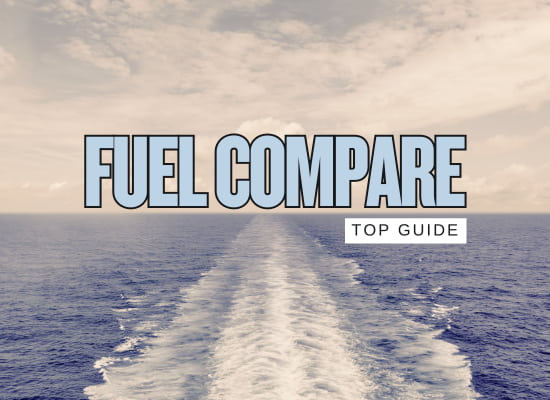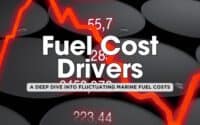Ship Fuel Showdown – Compare Costs Across Today’s Top Marine Fuels

With new environmental rules, rising fuel prices, and a growing menu of alternatives like LNG, methanol, and even hydrogen, shipowners and operators are facing more fuel choices than ever before.
But which one actually makes the most sense for your vessel? And how much does each option really cost over a typical voyage?
This interactive tool lets you compare estimated fuel costs for a standard 100-meter containership across today’s most-used and emerging marine fuels. Whether you're running on VLSFO or eyeing ammonia for your next green ship build, this breakdown will help point you in the right direction.

We welcome your feedback, suggestions, corrections, and ideas for enhancements. Please click here to get in touch.
ShipUniverse: Voyage Fuel Cost Estimator (2025 Beta)
| Select Ship Type: | |
| Select Voyage Length: | |
| Select Fuel Type: | |
 Estimated Fuel Burn and Cost: - Estimated Fuel Burn and Cost: -
|
|
Fuel decisions in maritime shipping are more complex than ever. With rising environmental pressures, shifting fuel prices, and evolving port infrastructure, shipowners must weigh multiple factors when selecting a fuel type. From traditional heavy fuel oil to emerging options like hydrogen and ammonia, each comes with its own balance of cost, compliance, and practicality. Below, we compare eight key fuel types shaping the future of global shipping.
 Heavy Fuel Oil (HFO)
Heavy Fuel Oil (HFO)Heavy Fuel Oil (HFO) is a viscous, low-cost fuel derived from the residuals of crude oil refining. Once the dominant marine fuel, its use has declined since 2020 due to environmental regulations — though it remains in use by ships equipped with scrubbers.
 Benefits:
Benefits:
- Low cost: HFO is typically 20–30% cheaper than cleaner marine fuels like MGO or VLSFO.
- Global availability: Still widely supplied in major ports around the world.
- Energy-dense: Offers high energy output per ton, making it efficient in terms of storage volume.
 Drawbacks:
Drawbacks:
- High emissions: Contains high sulfur, heavy metals, and leads to significant SOx, NOx, and PM emissions.
- Requires pre-treatment: Needs heating and filtration due to its thickness and contaminants.
- Not ECA compliant: Cannot be used in Emission Control Areas unless scrubbers are installed.
 Availability:
Availability:
- Still available globally but in lower volumes.
- Often used by ships with scrubbers to remain compliant with IMO 2020 sulfur limits.
- Restricted or banned in some Emission Control Areas.
 Outlook (2025 and Beyond):
Outlook (2025 and Beyond):
- Use expected to gradually decline due to decarbonization pressure.
- Will likely remain a transitional fuel for vessels with scrubbers.
- Ports may scale back storage as demand shrinks.
 Industry Pointer:
Industry Pointer:
- If your fleet still uses HFO, installing scrubbers is crucial for compliance and long-term viability.
- Monitor port availability and regional ECA rules before planning refueling strategies.
 Very Low Sulfur Fuel Oil (VLSFO)
Very Low Sulfur Fuel Oil (VLSFO)VLSFO is a marine fuel with a sulfur content of no more than 0.5%, designed to meet the IMO 2020 sulfur emissions cap. It quickly became the global shipping industry's primary fuel after HFO restrictions tightened.
 Benefits:
Benefits:
- Regulatory compliant: Meets IMO 2020 global sulfur cap without needing scrubbers.
- Widely available: Readily supplied at nearly all major bunkering ports worldwide.
- More cost-effective than MGO: While pricier than HFO, it's usually cheaper than Marine Gas Oil.
 Drawbacks:
Drawbacks:
- Fuel instability risks: Some VLSFO blends have shorter shelf lives and may degrade over time.
- Compatibility issues: Blended fuels from different suppliers may not mix well, requiring onboard segregation or fuel testing.
- Slightly lower energy content: Ships may burn more VLSFO than HFO for the same distance.
 Availability:
Availability:
- Widely available globally since 2020.
- Supported by most refineries and compliant with emission control area (ECA) regulations.
 Outlook (2025 and Beyond):
Outlook (2025 and Beyond):
- Still the dominant fuel for vessels without scrubbers.
- Expected to grow moderately as legacy fleets remain in service.
- Long-term future may be impacted by the rise of methanol, LNG, and other zero-carbon fuels.
 Industry Pointer:
Industry Pointer:
- Use a fuel testing service when switching between VLSFO suppliers — compatibility issues are the top cause of onboard fuel problems.
- Consider fuel conditioning systems to extend storage stability.
 Marine Diesel Oil (MDO)
Marine Diesel Oil (MDO)Marine Diesel Oil (MDO) is a blend of various distillates and residuals, serving as a middle-ground fuel between Heavy Fuel Oil (HFO) and Marine Gas Oil (MGO). It's commonly used in medium to high-speed marine engines.
 Benefits:
Benefits:
- Lower viscosity: Easier handling and storage compared to HFO, without the need for pre-heating.
- Moderate sulfur content: Typically contains less sulfur than HFO but more than MGO, balancing compliance and cost.
- Cost-effective: Generally cheaper than MGO, offering a compromise between price and performance.
 Drawbacks:
Drawbacks:
- Higher emissions than MGO: Produces more sulfur oxides (SOx) and particulate matter than cleaner distillates.
- Variable quality: Blending processes can lead to inconsistencies in fuel quality, affecting engine performance.
- Limited ECA compliance: May not meet sulfur limits in Emission Control Areas without additional measures.
 Availability:
Availability:
- Available in many ports but less prevalent than MGO and VLSFO.
- Supply may vary based on regional regulations and refinery outputs.
 Outlook (2025 and Beyond):
Outlook (2025 and Beyond):
- Usage expected to decline as stricter environmental regulations favor cleaner fuels.
- Potential niche applications where infrastructure for alternative fuels is lacking.
 Industry Pointer:
Industry Pointer:
- Regularly test MDO batches to ensure compatibility with engine systems.
- Stay informed about regional fuel regulations to maintain compliance during operations.
 Marine Gas Oil (MGO)
Marine Gas Oil (MGO)Marine Gas Oil (MGO) is a distillate marine fuel consisting solely of lighter fractions from crude oil refining. It is similar to diesel fuel and is commonly used in smaller vessels and auxiliary engines, as well as in Emission Control Areas (ECAs) due to its low sulfur content.
 Benefits:
Benefits:
- Low sulfur content: MGO typically has a sulfur content between 0.1% and 1.5%, making it compliant with stringent environmental regulations, especially within ECAs.
- Ease of use: Unlike heavier fuels, MGO does not require pre-heating, simplifying handling and storage procedures.
- High-quality fuel: Being a pure distillate, MGO offers better combustion properties and fewer impurities, leading to cleaner engine operation and reduced maintenance.
 Drawbacks:
Drawbacks:
- Higher cost: MGO is generally more expensive than heavier fuels like Heavy Fuel Oil (HFO) and Very Low Sulfur Fuel Oil (VLSFO), impacting operational costs.
- Lower energy density: MGO has a slightly lower energy content compared to HFO, which may result in increased fuel consumption for the same power output.
- Price volatility: The cost of MGO is subject to fluctuations in the crude oil market, which can lead to unpredictable operating expenses.
 Availability:
Availability:
- MGO is widely available in ports around the world, particularly in regions with stringent sulfur emission regulations.
- Its availability makes it a convenient choice for vessels operating in ECAs and for those without exhaust gas cleaning systems (scrubbers).
 Outlook (2025 and Beyond):
Outlook (2025 and Beyond):
- The demand for MGO is expected to remain stable, driven by its compliance with environmental regulations and the increasing establishment of ECAs.
- However, the adoption of alternative fuels and technologies aimed at reducing greenhouse gas emissions may influence its long-term usage.
 Industry Pointer:
Industry Pointer:
- Operators should monitor fuel price trends and consider the cost-benefit balance of using MGO versus other compliant fuels or technologies.
- It's advisable to stay informed about regional fuel availability and regulatory changes to ensure compliance and optimize operational efficiency.
 Liquefied Natural Gas (LNG)
Liquefied Natural Gas (LNG)Liquefied Natural Gas (LNG) is natural gas that has been cooled to a liquid state, reducing its volume for efficient storage and transportation. It has gained traction as a marine fuel due to its potential for lower emissions compared to traditional marine fuels.
 Benefits:
Benefits:
- Reduced emissions: LNG combustion produces significantly lower sulfur oxides (SOx), nitrogen oxides (NOx), and particulate matter compared to conventional marine fuels, aiding compliance with environmental regulations.
- Cost-effectiveness: LNG can be more cost-effective than low-sulfur marine fuels, especially in regions with well-developed LNG infrastructure, potentially leading to lower operating costs.
- Regulatory compliance: LNG enables compliance with stringent emission regulations, including those set by the International Maritime Organization (IMO).
 Drawbacks:
Drawbacks:
- High initial investment: The upfront costs for LNG-powered vessels, including retrofitting existing ships and building new ones, can be significantly higher than traditional ships.
- Methane slip: LNG engines may experience methane slip, where unburned methane—a potent greenhouse gas—is released into the atmosphere, potentially offsetting environmental benefits.
- Infrastructure requirements: The adoption of LNG requires specialized bunkering infrastructure, which may not be available in all ports, limiting operational flexibility.
 Availability:
Availability:
- LNG bunkering infrastructure is expanding globally, with significant investments in key ports to support the growing LNG-fueled fleet.
- Despite growth, infrastructure development varies regionally, and some areas may still lack adequate facilities.
 Outlook (2025 and Beyond):
Outlook (2025 and Beyond):
- The global fleet of LNG-fueled vessels is projected to double by 2025, driven by regulatory pressures and the industry's commitment to reducing greenhouse gas emissions.
- Ongoing advancements in LNG technology and infrastructure are expected to enhance its viability as a marine fuel, though challenges like methane slip need to be addressed to maximize environmental benefits.
 Industry Pointer:
Industry Pointer:
- Ship operators should weigh the long-term environmental and economic benefits of LNG against the initial investment and infrastructure considerations, staying informed about regional developments and regulatory changes.
- Investing in crew training and safety protocols is essential to manage the unique operational requirements of LNG-fueled vessels effectively.
 Methanol
MethanolMethanol is a liquid alcohol that has garnered attention as a marine fuel due to its potential to reduce emissions and its compatibility with existing infrastructure. It can be produced from natural gas, coal, biomass, or renewable sources, with 'green methanol' offering a pathway to carbon neutrality.
 Benefits:
Benefits:
- Lower emissions: Methanol combustion results in significantly reduced sulfur oxides (SOx), nitrogen oxides (NOx), and particulate matter compared to conventional marine fuels.
- Liquid at ambient conditions: Unlike LNG or hydrogen, methanol remains liquid at ambient temperature and pressure, simplifying storage and handling requirements.
- Biodegradable: Methanol is biodegradable and miscible in water, reducing environmental risks in case of spills.
- Existing infrastructure compatibility: Methanol can be used in modified conventional engines and can be bunkered using existing infrastructure with minor adjustments.
 Drawbacks:
Drawbacks:
- Lower energy density: Methanol's energy content is about half that of traditional marine fuels, necessitating larger storage volumes to achieve the same range.
- Corrosive properties: Methanol is corrosive to certain materials, requiring specific storage and handling arrangements.
- Low flashpoint: With a flashpoint of approximately 12°C, methanol is considered a low-flashpoint fuel, necessitating enhanced safety measures.
- Current cost and availability: The production of green methanol is still limited, and its cost is higher compared to conventional fuels, impacting economic feasibility.
 Availability:
Availability:
- Methanol is globally produced and transported, but its use as a marine fuel is still emerging. Availability is expected to improve as demand increases and infrastructure develops.
- Several ports are beginning to offer methanol bunkering, with more expected to follow as the market grows.
 Outlook (2025 and Beyond):
Outlook (2025 and Beyond):
- The adoption of methanol as a marine fuel is projected to grow, driven by stringent environmental regulations and the shipping industry's decarbonization goals.
- Investments in green methanol production are increasing, aiming to enhance its availability and reduce costs.
- Regulatory frameworks, such as the IMO's Interim Guidelines for methanol, are being developed to support its safe adoption.
 Industry Pointer:
Industry Pointer:
- Shipowners considering methanol should assess the feasibility of retrofitting existing vessels versus investing in new builds designed for methanol use.
- Staying informed about regional availability and regulatory developments is crucial for planning methanol adoption strategies.
- Collaborating with fuel suppliers and port authorities can facilitate the development of necessary bunkering infrastructure.
 Ammonia
AmmoniaAmmonia (NH₃) is emerging as one of the most promising zero-carbon marine fuels. As a compound of nitrogen and hydrogen, it can be burned without producing CO₂, making it a strong candidate for long-term decarbonization in shipping.
 Benefits:
Benefits:
- Zero carbon emissions: When burned or used in fuel cells, ammonia emits no carbon dioxide, supporting IMO climate goals.
- Global production footprint: Ammonia is already widely produced and transported for use in fertilizer, making global infrastructure scalable for marine use.
- Higher energy density than hydrogen: Ammonia is easier to store and transport than hydrogen, especially for long-range ocean voyages.
 Drawbacks:
Drawbacks:
- Highly toxic: Ammonia is dangerous to inhale or spill, requiring strong safety systems, training, and leak monitoring.
- Still mostly fossil-based: Most ammonia today is produced from natural gas; green ammonia is still scaling up and is more expensive.
- Low energy per volume: Ammonia requires about 2–3× more storage space than HFO to deliver the same range.
- Corrosive to some materials: Piping and storage tanks need special coatings and metallurgy to handle ammonia safely.
 Availability:
Availability:
- Ammonia is available globally thanks to decades of industrial production.
- Its availability as a marine fuel is growing but still limited to early-stage bunkering hubs.
 Outlook (2025 and Beyond):
Outlook (2025 and Beyond):
- Several shipbuilders have ammonia-ready engines in testing or under order for 2025–2027 launches.
- Global green ammonia production is increasing, with port projects underway in Asia, Europe, and the Middle East.
- Regulatory and safety frameworks are catching up, but operational standards are still in development.
 Industry Pointer:
Industry Pointer:
- If considering ammonia, invest early in safety training and design consulting — safety is the biggest barrier to scale.
- Ammonia may be most viable for large ocean-going vessels with frequent long-haul voyages and access to major bunkering ports.
 Hydrogen
HydrogenHydrogen is gaining attention as a potential zero-emission marine fuel, offering a pathway to decarbonize the shipping industry. When used in fuel cells or combustion engines, hydrogen produces only water vapor, eliminating CO₂ emissions.
 Benefits:
Benefits:
- Zero greenhouse gas emissions: Hydrogen combustion emits only water vapor, significantly reducing the environmental impact of maritime operations.
- Abundant resource: Hydrogen can be produced from various sources, including water electrolysis using renewable energy, enhancing energy security.
- Versatility: Suitable for use in fuel cells for electric propulsion or as a combustible fuel in modified internal combustion engines.
 Drawbacks:
Drawbacks:
- Storage challenges: Hydrogen has a low energy density by volume, requiring high-pressure tanks or cryogenic storage, which pose design and safety challenges.
- Production emissions: Most hydrogen today is produced from fossil fuels (grey hydrogen), resulting in CO₂ emissions. Green hydrogen, produced via renewable-powered electrolysis, is not yet widely available.
- Infrastructure limitations: The current lack of hydrogen bunkering facilities at ports limits its immediate applicability for widespread maritime use.
- Safety concerns: Hydrogen is highly flammable and requires stringent safety measures to prevent leaks and explosions.
 Availability:
Availability:
- Hydrogen production is established globally, but its use as a marine fuel is still in nascent stages.
- Green hydrogen availability is limited but expected to grow as renewable energy capacity increases.
- Pilot projects, such as hydrogen-powered ferries, are being introduced in regions like Norway and the United States.
 Outlook (2025 and Beyond):
Outlook (2025 and Beyond):
- Regulatory pressures and environmental goals are driving research and investment in hydrogen as a marine fuel.
- Technological advancements and economies of scale may reduce production and storage costs over time.
- Collaboration among stakeholders is essential to develop the necessary infrastructure and safety standards for hydrogen bunkering and utilization.
 Industry Pointer:
Industry Pointer:
- Shipowners should monitor developments in hydrogen technology and infrastructure to assess its viability for future fleet integration.
- Engaging in pilot projects and partnerships can provide valuable insights into operational challenges and solutions related to hydrogen fuel adoption.
Table Summary
| ShipUniverse: Marine Fuel Comparison | |||||
| Fuel Type | Benefits | Drawbacks | Typical Cost (2025 est.) | Availability | Outlook (2025+) |
| HFO |  Cheap, energy-dense, globally available if scrubbers are used. Cheap, energy-dense, globally available if scrubbers are used. |
 High in sulfur and emissions. Not ECA-compliant without scrubbers. High in sulfur and emissions. Not ECA-compliant without scrubbers. |
$500/ton – among the cheapest fuels, but limited by regulations. | Available at most major ports but declining in volume. | Use declining steadily. Scrubber-equipped ships may continue using it as long as allowed. |
| VLSFO |  IMO 2020 compliant. No scrubber needed. Available almost everywhere. IMO 2020 compliant. No scrubber needed. Available almost everywhere. |
 Stability issues in some blends. Slightly lower energy content than HFO. Stability issues in some blends. Slightly lower energy content than HFO. |
$600/ton – more expensive than HFO, less than MGO. | Widely available at all major bunkering hubs. | Mainstream fuel for non-scrubber ships. Expected to hold steady for a few more years. |
| MDO |  No need for pre-heating. Burns cleaner than HFO. Moderate price point. No need for pre-heating. Burns cleaner than HFO. Moderate price point. |
 Higher emissions than MGO. Less availability than VLSFO or MGO. Higher emissions than MGO. Less availability than VLSFO or MGO. |
$850/ton – middle ground between HFO and MGO. | Available in many ports, but less common than MGO. | Use expected to decline slowly. Still used where infrastructure doesn’t support alternatives. |
| MGO |  Very low in sulfur. Fully ECA-compliant. Easy to store and burn. Very low in sulfur. Fully ECA-compliant. Easy to store and burn. |
 Highest cost of traditional fuels. Lower energy content than HFO. Highest cost of traditional fuels. Lower energy content than HFO. |
$900/ton – premium price due to purity and compliance. | Reliable availability in ECA regions and major ports. | Steady demand in emission-controlled waters. Likely to remain relevant for years. |
| LNG |  Burns cleaner than oil-based fuels. Lower NOx, SOx, and CO₂ emissions. Suitable for dual-fuel engines. Burns cleaner than oil-based fuels. Lower NOx, SOx, and CO₂ emissions. Suitable for dual-fuel engines. |
 Methane slip (unburned methane) remains an environmental concern. Requires cryogenic storage and training. Methane slip (unburned methane) remains an environmental concern. Requires cryogenic storage and training. |
$400/ton – competitive cost, but prices can vary based on region and demand. | Available at an increasing number of ports. Europe and Asia are leading LNG bunkering hubs. | Growing adoption expected. Seen as a bridge fuel toward zero-carbon solutions. |
| Methanol |  Can run in modified diesel engines. Lower emissions profile. Liquid at ambient temperature. Can run in modified diesel engines. Lower emissions profile. Liquid at ambient temperature. |
 Lower energy content means higher consumption. Current production is still fossil-based in most regions. Lower energy content means higher consumption. Current production is still fossil-based in most regions. |
$375/ton – low price, but fuel burn is higher due to low energy density. | Expanding availability, especially in Europe and China. Supported by new vessel orders. | Gaining traction fast. Green methanol will shape its long-term viability. |
| Ammonia |  No carbon emissions when burned. Higher energy density than hydrogen. Produced globally for fertilizer use. No carbon emissions when burned. Higher energy density than hydrogen. Produced globally for fertilizer use. |
 Highly toxic. Requires safety systems, new bunkering protocols, and corrosion-resistant equipment. Highly toxic. Requires safety systems, new bunkering protocols, and corrosion-resistant equipment. |
$700/ton – moderately priced, with green ammonia expected to cost more initially. | Infrastructure limited but in development. Multiple ports planning pilot bunkering projects. | Still early-stage but heavily backed by industry and governments as a zero-carbon fuel. |
| Hydrogen |  Zero emissions when used in fuel cells. Ideal for short-sea shipping. Can be produced from water and renewable energy. Zero emissions when used in fuel cells. Ideal for short-sea shipping. Can be produced from water and renewable energy. |
 Expensive. Requires high-pressure or cryogenic storage. Infrastructure and safety protocols are still developing. Expensive. Requires high-pressure or cryogenic storage. Infrastructure and safety protocols are still developing. |
$6000/ton – very high cost due to production and handling challenges. | Very limited availability. Mostly used in pilot projects and inland/short routes. | Long-term potential as tech evolves, but likely reserved for niche maritime applications in the near future. |

Do you have a Maritime Product or Service that may be of interest to Shipowners? Tell us about it here!
Do you have feedback or insights? Please reach out to editor @ shipuniverse.com




